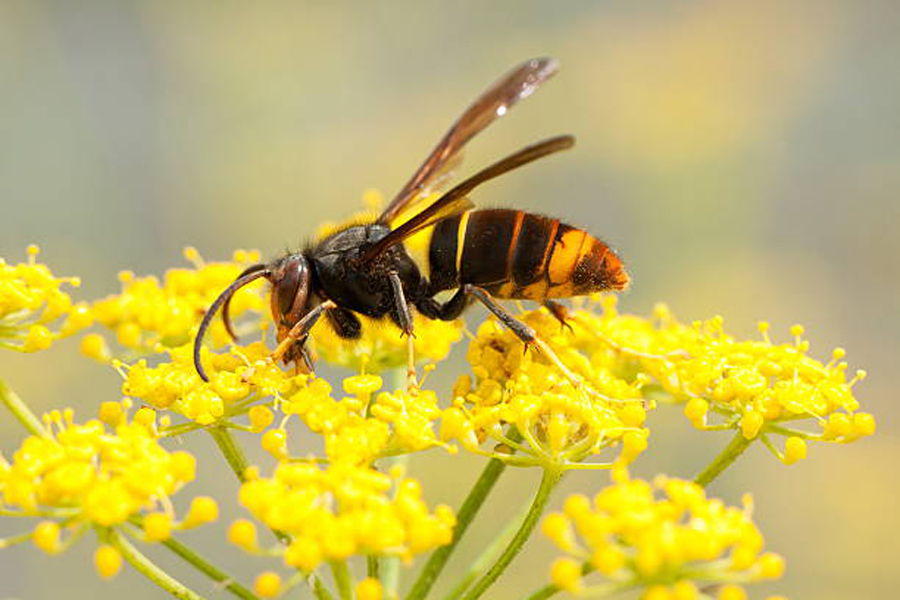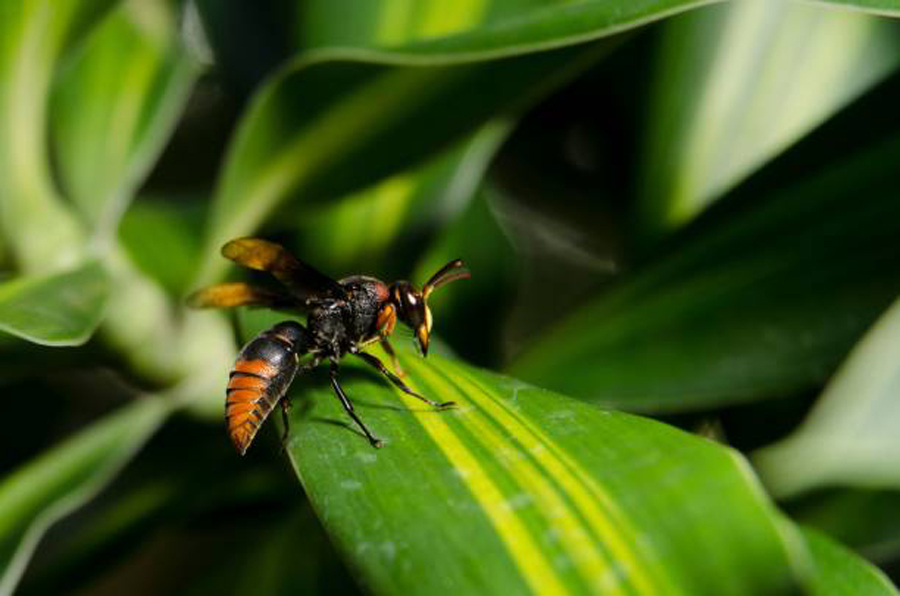The Asian hornet (Vespa velutina), also known as the yellow-legged hornet, is a species native to Southeast Asia. In recent years, it has become an invasive species in Europe, causing significant concern for the UK’s ecosystem. This comprehensive article will explore the biology, behaviour, and ecological impact of this aggressive and adaptable insect. We will also delve into the measures taken to control and manage the presence of Asian hornets in the UK, as well as the potential consequences if left uncontrolled.
Biology and Behaviour of the Asian Hornet
Physical Characteristics
The Asian hornet is a member of the Vespidae family and is slightly smaller than its European counterpart, the European hornet (Vespa crabro). Adult workers measure between 25 and 30 millimetres, while the queen can reach up to 35 millimetres in length. It is distinguishable by its dark brown or black velvety body, with a characteristically bright yellow-orange band on its fourth abdominal segment and yellow legs.
Life Cycle and Nest Construction
The life cycle of the Asian hornet begins when a fertilised queen emerges from hibernation in early spring. She builds a small nest, usually in a sheltered location such as a tree cavity, hedge, or building eave. Here, she lays her eggs and raises her first generation of workers. Once these workers hatch and mature, they take over foraging and nest construction duties, allowing the queen to focus solely on laying eggs. Over the summer, the colony grows exponentially, with the nest reaching sizes of up to 1 metre in diameter and housing thousands of hornets.
The nests are constructed from a mixture of plant material and hornet saliva, which forms a papery substance. The nests consist of multiple layers of hexagonal combs, each containing larvae in various stages of development, and are covered in a protective outer envelope.
Feeding Habits and Predatory Behaviour
Asian hornets are diurnal predators, feeding primarily on other insects such as flies and wasps. However, they are particularly notorious for their predation of honeybees, which poses a substantial threat to honeybee populations and the pollination services they provide. The hornets have a voracious appetite and can decimate entire bee colonies in a matter of hours by targeting foraging bees, chopping them into pieces, and taking the protein-rich thorax back to their nest to feed their larvae.
Asian hornets employ a hunting technique known as “hawking”, where they hover outside the entrance of a bee colony and capture returning forager bees in mid-air. They then proceed to dismember the captured bee, discarding the head, legs, and abdomen, and return to their nest with the protein-rich thorax to feed their developing larvae.

Invasion of the Asian Hornet in the UK
History and Spread
The first sighting of the Asian hornet in Europe was recorded in France in 2004, likely arriving through an accidental importation in a shipment of pottery from China. The hornet rapidly spread throughout France, establishing a stronghold and further expanding its range to neighbouring countries, including Spain, Portugal, Italy, Belgium, and Germany. The first official sighting of the Asian hornet in the UK occurred in 2016 in Tetbury, Gloucestershire.
Current Distribution and Potential Range Expansion
Since then, the UK has been on high alert, with various sightings and nest discoveries reported across the country, particularly in the South West. Although the number of confirmed nests has been relatively low, it is feared that the true scale of the problem could be much larger, with many nests going undetected. The Asian hornet’s adaptability to different climates and habitats, combined with the availability of suitable nesting sites and prey, makes it likely that its range will continue to expand across the UK.
The potential for further range expansion is also influenced by climate change, as rising temperatures may create more suitable conditions for the Asian hornet to thrive. This could lead to a wider distribution of the species throughout the UK, exacerbating the threats to native ecosystems and honeybee populations.
Ecological Impact and Threat to the UK’s Ecosystem
Impact on Honeybees and Pollination Services
The introduction of the Asian hornet to the UK poses a significant ecological threat, primarily due to its predation of honeybees and other pollinators. Honeybees play a vital role in the ecosystem, as they are responsible for pollinating a vast range of plants, including many of the crops that make up our food supply. A decline in honeybee populations could lead to a reduction in crop yields and a subsequent increase in food prices.
Consequences for Native Insect Populations and Ecosystem Balance
Furthermore, the Asian hornet is not the only species affected by its presence. The hornet’s aggressive behaviour and voracious appetite can cause a decline in native insect populations, leading to knock-on effects throughout the ecosystem. The loss of insect diversity can impact the food chain, affecting other species such as birds and small mammals that rely on insects as a primary food source. Moreover, a reduction in insect populations can also disrupt natural pest control processes, as many insects prey on crop pests.
Public Health and Safety Concerns
In addition to its ecological impact, the Asian hornet’s presence poses a threat to public health and safety. While the venom of the Asian hornet is not more potent than that of native species, its aggressive behaviour can lead to multiple stings in a short period, increasing the risk of a severe reaction. This is particularly concerning for individuals who are allergic to wasp and bee venom, as they may experience anaphylactic shock, a life-threatening allergic reaction.

Control and Management of the Asian Hornet in the UK
Public Awareness and Reporting
The UK government and various organisations have implemented measures to control and manage the presence of the Asian hornet. The Department for Environment, Food and Rural Affairs (DEFRA) has developed an Asian Hornet Action Plan, outlining steps to prevent the establishment of the species, as well as strategies for early detection, containment, and eradication.
Public awareness and citizen science play a crucial role in the early detection of Asian hornets. The public is encouraged to report sightings of the hornets or their nests through the Asian Hornet Watch app or directly to local beekeeping associations. Once a sighting is confirmed, a team of experts is deployed to locate and destroy the nest.
Nest Detection and Eradication
Nest detection and eradication efforts are critical to preventing the establishment and spread of the Asian hornet. This is usually done by injecting an insecticide into the nest, which kills the hornets and prevents the release of the queen and her offspring, thus preventing further spread.
Additionally, research is being conducted to develop novel methods of controlling the Asian hornet. For example, researchers at the University of Exeter have developed a tracking device that can be attached to individual hornets, allowing them to be followed back to their nest. This technology has the potential to greatly improve the efficiency of nest detection and eradication efforts.
Protective Measures for Beekeepers
Beekeepers are also taking measures to protect their colonies from hornet predation. This includes the use of hornet-proof mesh on hive entrances, which allows bees to enter and exit while keeping hornets out, and the deployment of hornet traps. In some cases, beekeepers have even adapted their hives to include ‘bee hotels’ – areas where bees can take refuge from hornet attacks. These proactive measures can help reduce the impact of Asian hornets on honeybee colonies and support their survival.
Collaborative Efforts and Future Research
To effectively combat the threat of the Asian hornet, collaboration between government agencies, research institutions, and local communities is essential. By sharing knowledge and resources, stakeholders can develop and implement more effective strategies for the detection, containment, and eradication of this invasive species.
Future research should focus on understanding the Asian hornet’s behaviour, ecology, and potential impacts on native ecosystems. By studying the hornet’s biology and life cycle, researchers can identify potential weaknesses that can be exploited for control purposes. In addition, research should explore the development of new methods and technologies for monitoring and controlling the Asian hornet, such as the use of biological control agents, pheromone traps, and remote sensing technology.
Conclusion
The Asian hornet’s invasion of the UK presents a significant threat to the country’s ecosystem and honeybee populations. Its aggressive behaviour, adaptability, and predation of honeybees have raised alarm bells, prompting both government and public action to prevent its establishment and spread. Through vigilant monitoring, early detection, and innovative control methods, the UK can work towards mitigating the impact of this invasive species and preserving its vital pollinator populations. Collaboration between stakeholders, investment in research, and public awareness campaigns will be essential in the fight against the Asian hornet and the protection of the UK’s precious ecosystems.
Additional Resources
Sam loves to learn about animals and their habitats. He has been a nature lover from a very young age, and has been writing papers and articles about wildlife for as long as he can remember.
